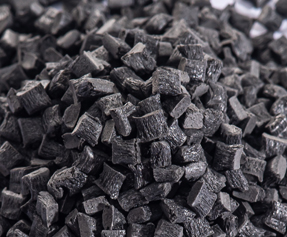
From Prototype to Production
— Selecting the Right
Injection Molded Materials
“If it ain’t broke, don’t fix it.” Are you following this rule by choosing the same materials for your injection molded products just because they worked well in the past? It’s understandable, but selecting the right injection molded material is a critical yet challenging task due to numerous options. However, this approach may not always be the best choice. To select the best injection molded material, product designers have to thoroughly understand the material properties and consider the specific application needs. Let’s dive into these further in this article about thermoplastic materials.
Thermoplastic Materials Classified According to Molecular Structure
Thermoplastic materials can be classified based on their molecular structure into two main categories: amorphous plastics and semi-crystalline plastics.
1. Amorphous Plastics: These plastics have a disordered molecular structure both in molten and solid states. When cooled from a molten state, they transition from a rubbery state to a glassy state below their glass transition temperature. Common examples include PC, PPO, ABS, PMMA, PVC, and PEI.
2. Semi-crystalline Plastics: These have a partially ordered molecular structure in their solid state, forming crystalline regions that are denser and more tightly packed. The degree of crystallinity depends on the molecular structure and molding conditions. Examples include POM, PET, PBT, PA, PPS, and PEEK.

Characteristics of Amorphous and Semi-crystalline Plastics
Applications of Common Thermoplastic Materials
1. General-purpose Plastics: These have lower mechanical properties and are used for non-structural applications due to their ease of molding and low cost. Examples include PE, PP, EEA, and PVC, which are widely used in films, pipes, footwear, containers, and packaging materials.
2. Standard Engineering Plastics: These materials have moderate mechanical properties and are used in engineering for non-load-bearing applications. Examples include PS, HIPS, ABS, AAS, ACS, MBS, AS, and PMMA, commonly used for housings and casings.


3. Structural Engineering Plastics: These have higher mechanical properties and are used for structural components that bear significant loads. Examples include PA, PPO, POM, PC, PBT, and PET, widely used in various housings and structural components.
4. High-temperature Engineering Plastics: These maintain high mechanical properties under high temperatures and are used in applications such as automotive engine parts, oil pump covers, and high-temperature electrical connectors. Examples include PI, PPS, PSF, PAS, and PAR.
5. Plastic Alloys: These are high-performance, functional, and specialized materials created by blending or grafting different plastics, such as PC/ABS, PC/PBT, and PC/PMMA. They are used in automotive, electronics, precision instruments, office equipment, packaging, and construction materials, enhancing performance while reducing costs.


6. Thermoplastic Elastomers (TPE): These materials exhibit properties between rubber and plastic, offering elasticity and easy processability. They are used in automotive, electronics, electrical, construction, engineering, and daily-use products like sheaths, tubing, cables, gaskets, parts, footwear, and adhesives.
7. Modified Plastics: These are enhanced by adding additives, fillers, and reinforcements like glass fibers, conductive fibers, flame retardants, impact modifiers, and stabilizers to improve specific properties such as flame resistance, mechanical strength, impact resistance, high-temperature resistance, wear resistance, and conductivity. An example is Fiberglass Reinforced Plastics (FRP), a high-strength, high-performance material used in automotive, machinery, electronics and ships, offering a lightweight, rust-free, cost-effective alternative to traditional metals.
Pros and Cons of Common Thermoplastic Materials
Explores the pros and cons of several common thermoplastic materials, providing valuable insights for material selection. Below is a detailed analysis of these materials.
Work with Engineering Experts
Material properties can significantly impact component design, including wall thickness, rib thickness, screw hole dimensions, and more. With over 20 years of experience, RPWORLD provides comprehensive manufacturing solutions to help you navigate these complexities and optimize your product design, and MORE BENEFITS:
1. Expert Guidance: Our engineers help you select the best materials and design for your application, ensuring optimal performance and cost-efficiency. Thermoplastics share similar properties, but differences can make one material more suitable than another based on your specific requirements.
2. Advanced Injection Molding: quipped with state-of-the-art presses and robot arms, our facility produces high-quality parts using 100+ engineering-grade plastics. We handle production runs from 100 to 100,000+ pieces.
3. Rapid Prototyping and Production: Our on-demand services can accelerate your product development by up to 80%, delivering parts in as fast as 7 days.

As we all know that this is a pocket-sized guide that lists specific material properties to help you choose the right materials for your injection molded parts. Contact Us now to get additional guidance.